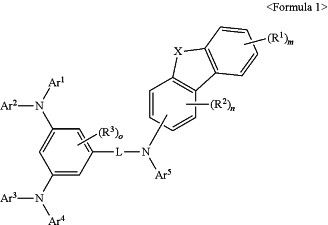| CPC H10K 85/636 (2023.02) [C07D 209/88 (2013.01); C07D 333/76 (2013.01); C07D 409/12 (2013.01); C09K 11/06 (2013.01); H10K 85/633 (2023.02); C09K 2211/1018 (2013.01); H10K 50/11 (2023.02); H10K 85/615 (2023.02); H10K 85/626 (2023.02); H10K 85/6572 (2023.02); H10K 85/6574 (2023.02); H10K 85/6576 (2023.02); H10K 2101/10 (2023.02)] | 12 Claims |
|
1. An organic electric element comprising:
a first electrode;
a second electrode; and
at least one organic material layer including a light emitting layer positioned between the first electrode and the second electrode,
wherein the organic material layer includes a hole transport layer between the first electrode and light emitting layer,
wherein the hole transport layer contains a compound represented by Formula 1:
 in Formula-1:
1) X is any one of S, O, and NAr6;
2) Ar1 to Ar6 each are independently selected from the group consisting of a C6-C60 aryl group, a C2-C60 heterocyclic group containing at least one heteroatom of O, N, S, Si, a fluorenyl group, a fused ring group of a C6-C60 aromatic ring and a C3-C60 aliphatic ring, a C1-C50 alkyl group, a C2-C20 alkenyl group, a C2-C20 alkynyl group, a C1-C30 alkoxy group, and a C6-C30 aryloxy group;
3) R1 to R3 each are independently selected from the group consisting of deuterium, tritium, halogen, a cyano group, a nitro group, a C6-C60 aryl group, a fluorenyl group, a C2-C60 heterocyclic group containing at least one heteroatom selected from the group consisting of O, N, S, Si, and P, a fused ring group of a C3-C60 aliphatic ring and a C6-C60 aromatic ring, a C1-C50 alkyl group, a C2-C20 alkenyl group, a C2-C20 alkynyl group, a C1-C30 alkoxy group, and a C6-C30 aryloxy group, in the presence of a plurality of R1's and R2's, at least one pair of neighboring R1's and R2's independently may bind to each other to form a ring, provided that R1's and R2's forming no ring are the same as defined above;
4) m is an integer of 0 to 4, and when m is an integer of 2 or greater, R1's are the same as or different from each other;
5) n and o each are independently an integer of 0 to 3, and when n and o each are an integer of 2 or greater, R2's and R3's each are the same as or different from each other; and
6) L is represented by one of Formula L1 to L6 below:
 wherein in Formulas L1 to L6:
7) Y is any one of S, O, NAr7, and CAr8Ar9;
8) Ar7 to Ar9 each are independently selected from the group consisting of a C6-C60 aryl group, a fluorenyl group, a C2-C60 heterocyclic group containing at least one heteroatom of O, N, S, Si, and P, a fused ring group of a C6-C60 aromatic ring and a C3-C60 aliphatic ring, a C1-C50 alkyl group, a C2-C20 alkenyl group, a C2-C20 alkynyl group, a C1-C30 alkoxy group, and a C6-C30 aryloxy group, and Ar8 to Ar9 may bind to each other to form a spiro compound together with a carbon atom to which they are bound;
9) R4 to R12 each are independently selected from the group consisting of deuterium, tritium, halogen, a cyano group, a nitro group, an aryl group, a fluorenyl group, a C2-C60 heterocyclic group containing at least one heteroatom selected from the group consisting of O, N, S, Si, and P, a fused ring group of a C3-C60 aliphatic ring and a C6-C60 aromatic ring, a C1-C50 alkyl group, a C2-C20 alkenyl group, a C2-C20 alkynyl group, a C1-C30 alkoxy group, and a C6-C30 aryloxy group, in the presence of a plurality of R10's and R12's, at least one pair of neighboring R10's, R11's, and R12's independently may bind to each other to form a ring, provided that R10's to R12's forming no ring are the same as defined above;
10) a, c, and d each are independently an integer of 0 to 4, and when a, c, and d are each an integer of 2 or greater, R4's, R6's, and R7's are the same as or different from each other;
11) b is an integer of 0 to 8, and when b is an integer of 2 or greater, R5's are the same as or different from each other;
12) e is an integer of 0 to 2, and when e is an integer of 2 or greater, R8's are the same as or different from each other;
13) f is an integer of 0 or 1; and
14) g, h, and i each are independently an integer of 0 to 3, and when g, h, and i are each an integer of 2 or greater, R10's to R12's are the same as or different from each other,
wherein the aryl group, fluorenyl group, heterocyclic group, fused ring group, alkyl group, alkenyl group, alkynyl group, alkoxy group, and aryloxy group of Ar1 to Ar6, R1 to R3, Ar7 to Ar9, and R4 to R12 each may be further substituted with one or more substituents selected from the group consisting of deuterium, halogen, a silane group substituted or unsubstituted with a C1-C20 alkyl group or a C6-C20 aryl group, a siloxane group, a boron group, a germanium group, a cyano group, a nitro group, a C1-C20 alkylthio group, a C1-C20 alkoxy group, a C1-C20 alkyl group, a C2-C20 alkenyl group, a C2-C20 alkynyl group, a C6-C20 aryl group, a C6-C20 aryl group substituted with deuterium, a fluorenyl group, a C2-C20 heterocyclic group containing at least one heteroatom selected from the group consisting of O, N, S, Si, and P, a C3-C20 cycloalkyl group, a C7-C20 arylalkyl group, and a C8-C20 arylalkenyl group, and when the substituents are adjacent to each other, the substituents may bind to each other to form a ring,
with the proviso that, if X is O or S, L is not L1.
|